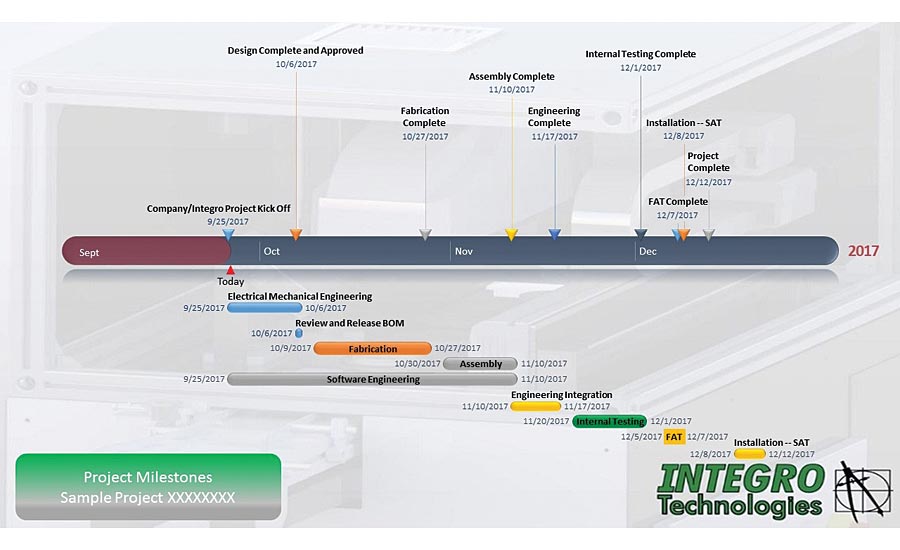You diligently worked up the proposal. You were conservative in estimating material and labor, and you won the job. What could possibly go wrong? Twenty weeks later, a profit and loss report, dripping in red ink, lands on your desk, and your boss wants to see you in his office. Where did the profits go?
Profit leaks spring from many sources. Any time material is ordered incorrectly and needs to be returned, unplanned expenses are obviously added. Similarly, mistakes in machining or assemblies that require rework diminish the bottom line. Another glaring leak source is extra time spent on-site during installation and startup, either spent waiting for a customer to allow line access or to modify a system to accommodate overlooked details or needs that should have be addressed in the beginning of the project.
Less obviously, project holds or delays affect the bottom line in a more subtle manner. It is inefficient to integrate an application in starts and stops, as opposed to working on one task until finished. But stringing out a project can cause an expanding circle of effects, as engineers will not be available at the scheduled date for other projects, leading to a cascading effect of delays and cost increases.
Maintain tight cost control and minimize project profit leaks by investing time upfront to document the following critical tasks and milestones, prior to accepting an order: scope of work documentation, factory acceptance testing, site acceptance testing for installation and startup. The flow from the most common profit leaks will be reduced to a minimum by documenting clear and specific scope tasks, adhering to tight and realistic project milestone dates documented in a Gantt chart for all to see, validating the deliverables on the shop floor with a factory acceptance test prior to shipment, and limiting time spent on site.
Scope of Work
Poorly worded scope documents can result in cost increases from “mission creep.” That is, your language wasn’t precise enough to restrict the deliverables to what you had intended.
Expanded deliverables and capabilities can be justified by the customer if the scope deliverables are not precisely defined. Unanticipated and unbudgeted scope changes increase costs by project delays, additional manpower requirements, reworked equipment and/or additional hardware purchases. Not meeting customer expectations negatively affects future business as well.
It is vital to know what to include in the scope of work documentation. At the most basic level, what is your responsibility and what is the customer’s. What you will do, and more importantly, what you won’t do.
As a machine vision integrator, our company requires very specific information in the scope of work documentation. For example, we need to know a customer’s machine capabilities and exactly what they want to accomplish with a machine vision solution: how fast, how many per minute, how many SKUs, what accuracy, what resolution, in short anything you can think of to narrow the scope of work to specific items.
Delivery dates and milestones that are tied into the customer’s tasks need to be spelled out. If the customer can’t execute his or her responsibilities in a timely manner, the initial delivery date is invalid, without penalty to your company.
As integrators, it is vital for the delineation of tasks for the customer, both before and after the system is on site, should be addressed. Who provides electricity and air, internet access, cabling, machine hookup, runs conduit and mounts the system to the floor? If you are installing in a manufacturing plant that has a union, it is particularly paramount to have these answers before you even step on the plant floor.
It is important to have verbiage in your proposal that time on-site due to failures of the customer to execute his or her tasks in a timely manner will result in extra hours and expenses being billed to the customer. The reality is that we tend to avoid customer conflict, and we don’t like to invoke this clause, but the presence of it in the documentation provides reinforcement for dispute resolution.
Finally, the scope of work should document the acceptance criteria for the installed system. Again, get as specific as possible to the number of parts handled, system throughput, HMI look and feel, etc. The goal is to get in and out of a customer site in the shortest time possible.

Project Management Gantt Chart.
Factory Acceptance Testing
Narrowly defining the scope of a project’s deliverables and having a customer sign off on them prior to shipment during a Factory Acceptance Test (FAT) reduces risks of unexpected costs. It also ensures that any changes are funded by the customer with a change order, and ultimately, the project will goes smoother with a happy customer that will purchase additional machines.
FATs avoid costs incurred on the job site during start up. Revisions done on the customer’s site are more expensive, less efficient, and result in delays to the current project. Additional project delays can occur as scheduled manpower is no longer available due to the unexpected rework.
The site acceptance criteria that was documented in the scope should serve as a road map for this phase, as well as a rehearsal for the site acceptance test itself. Many customers have specific vendor acceptance criteria they will use to judge the system. Obtain those documents in advance to make sure that there are no surprises. If changes need to be made, either covered by scope or a change order, making those changes prior to the system leaving the factory will be the most efficient and cost effective.
Site Acceptance Testing
If you’ve done the above tasks well, this should go as smoothly as possible, at least for the items within your control. Verify the customer will have his tasks complete, that the line will be down, and you will have access, the equipment will be in in place, the conduit has been installed and wires pulled, before the installation team leaves your facility. If the FAT was successful, surprises on-site should be reduced and costs incurred on the job site during start up should be minimized.
The most likely source of problems will be due to unforeseen circumstances on the customer’s part. If the documentation was done well, any downtime on-site for your team will be billable to the customer per the proposal.
Hidden costs always arise, regardless of how well you try to avoid them. The best you can do is to try to minimize them by delivering a proposal that provides, in great detail, what you will do and what you won’t do. This document then becomes the document of record, a legally binding contract. Adhering to the deliverables listed in the scope of work document, demonstrating them at a FAT and turning those FAT results into a smooth and successful installation, you ensure that you have minimized unforeseen costs, or, when they occur, getting your customer to pay for them.

